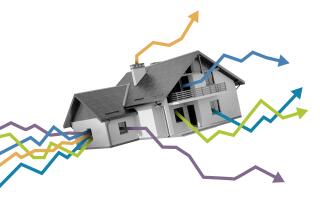Spring Break : Home Sale Slump Has Bottomed Out, Southland Realtors, Builders Say
- Share via
When veteran realtor Helen Rowe put a handsome but modest two-bedroom home in West Los Angeles up for sale last month, she figured that the home would sell relatively fast.
Sure, Rowe knew that the real estate market has been in the doldrums: Resales in the Los Angeles area are down 41% from a year ago.
But this home was priced competitively and, in realtorspeak, was in “move-in condition”--immaculate, well-kept and in no need of repairs.
What happened next surprised even Rowe, who has been selling real estate for almost 30 years. The first day, she didn’t get a single offer on the property.
Instead, she got six--one of them for the seller’s full asking price of $495,000.
“It reminded me of 1987 or ‘88, when things were so crazy,” Rowe said. “I thought the property would sell fast, but I had no idea it would sell this fast.”
Across the Southland, there’s a growing sentiment among realtors, builders, lenders and other experts that the dormant housing market has snapped out of its 18-month slumber.
They say a combination of factors--a short and successful Gulf War, renewed consumer confidence, lower mortgage rates and bargain-basement home prices--has had buyers coming out in droves since mid-January.
And while few believe that the housing market will soon return to the heady days of ’87 and ‘88, when prices in many areas jumped 20% a year and homes often sold as soon as they were listed, many experts say that the market has bottomed out and is on its way back up.
“I think the train is finally leaving the station,” summed up Leslie Appleton-Young, an economist for the California Assn. of Realtors.
Looking at the statistics provided by the realty trade group, it’s hard to make the case that the resale market has finally turned around. Sales are down from Santa Barbara to San Diego, and prices are little changed from a year ago.
But the realty group’s figures--which the media uses widely when reporting about the health of the housing market--can be misleading.
That’s because they only track transactions that have already been finalized-- they don’t reflect deals that have recently been struck but have yet to close escrow.
“All of our members are telling us that business has picked up over the last month or so, and that they’re selling more homes,” Appleton-Young said. “But those sales won’t show up in our statistics for a couple of more months, until all those escrows close and all those keys change hands.”
Many realtors think that a lot of keys will soon be changing hands, especially now that the prime spring home-buying season is here.
“I just gave a speech to 200 of our agents, and I asked them, ‘How many of you think that the market has bottomed out?’ ” said Rick Merrill, president of Prudential California Realty.
“Every single one of them raised their hand.”
Those agents have good reason for being optimistic: Sales at Prudential’s 70 Southland offices in February alone were 50% above January levels. And on the pricey Westside, first-quarter sales are running 70% above the rate posted in the fourth quarter of last year.
“The market just seems to be getting stronger and stronger,” Merrill said.
Jon Douglas Co., one of the largest real estate brokerages in the San Fernando Valley and West Side markets, also reports a big upturn in sales.
“We went nine months without having a single $100-million week, but now we’ve had three in a row,” said Jon Douglas, the company’s founder.
“I think a lot of the slowness we saw up until January was caused by a ‘buyers’ rebellion’ against the big price increases we saw in ’87 and ‘88,” he said. “Now rates are down, the economy is looking better and prices have moderated. The rebellion, I’m happy to say, is over.”
Sales are also up at Century 21, whose 500 offices south of Bakersfield make it the Southland’s biggest brokerage outfit.
The three regional branches that comprise the bulk of the realty giant’s Southern California operations saw nearly 8,500 homes go into escrow last month, up more than 25% from January.
Some C-21 offices are faring even better than others. At Century 21 A Marketplace in Long Beach, broker Phil Jones expects his staffers to sell at least 80 homes this month--twice the amount they sold in February.
“We’ve got a big bell hanging on the wall that we ring every time one of our agents gets a listing or makes a sale,” Jones said. “Lately, it sounds more like we’re working in a fire station, not a real estate office.”
The sales pace in the San Fernando Valley has also quickened.
Realtors at James R. Gary East Ltd., a big brokerage firm headquartered in Studio City, sold nearly twice as many homes in February as they did a year ago.
“All those people who were sitting on the fence are jumping down and starting to buy,” said Temmy Walker, the company’s president.
In the San Gabriel Valley community of Arcadia, officials at the local Coldwell Banker office expect their agents to sell between 40 and 50 homes this month--twice the number of homes they sold in March of last year.
“Even the phone calls we’re getting have changed,” said Marie Murphy, manager of Coldwell’s Arcadia branch.
“A few months ago, lots of people were calling and saying, ‘I want to sell my home.’ Now, most of our callers are saying, ‘I want to buy a home.’ ”
The story is the same in South Orange County and San Diego. Realtors in the San Clemente office of Grubb & Ellis sold 25 homes in all of January: In the first three weeks of March, they sold more than 30.
“Buyers like the low mortgage rates, and they know there are some good deals out there,” said Paul Yoder, a Grubb & Ellis district manager. “I hate to use this old cliche, but now is a good time to buy.”
The renewed interest among buyers is also good news for home builders, many of whom are coming off one of the worst years for new housing since the 1981-82 recession.
Watt Industries Inc., for example, has long been one of Southern California’s biggest builders. But the 2,033 homes it built in 1990 was 20% below its ’89 output, and the downturn forced it to lay off hundreds of workers.
But two months ago, sales at its 20 Southland tracts shot up dramatically.
“Back in November or December, we were selling between 13 and 19 homes a week,” said Ted Cox, Watt’s president. “Then mid-January rolled around, and we started selling 25 or 30 a week. We’ve been doing gradually better ever since.”
Sales have also surged at Kaufman & Broad, another big home builder. In the three-month period that ended Feb. 28, the company sold about 780 homes in the state--a 20% rise from a year ago.
Equally important, the company now has orders for nearly 1,000 homes in California. Just three months ago, its so-called “backlog” was less than 550.
“Everything just seemed to take off in January, when the ‘shooting war’ started in the Gulf,” said Bruce Karatz, Kaufman & Broad’s president and chief executive.
“I think the war gave everyone a psychological lift, and it helped a lot of people put their fears about the recession aside. Consumers have got their confidence back, and that’s what you need to sell homes.”
Builders who cater to the first-time buyers market--generally, homes selling for $150,000 or less in the Inland Empire and $250,000 or less in more urbanized markets such as Orange County--still account for the lion’s share of new-home sales.
Van Daele Development, a company that primarily builds homes in the $150,000-range, sold 290 houses in the first 10 weeks of the year--compared to just 81 homes in the previous 10 weeks.
But developers who build more expensive houses for “trade-up” buyers say they’re enjoying a big upswing in sales too.
“The ‘trade-up’ market has gotten a boost because the resale market has finally picked up,” said Eric Brown of the Meyers Group, an Encino-based real estate research and consulting group.
“It’s a pretty simple equation: You can’t buy a more expensive home if you can’t sell the one you already own. Now that the resale market is doing better, people are looking at nicer, new homes again.”
Prices for new homes have dropped in many parts of the Southland over the last year, and have remained stagnant in most others. But that too could soon change, as inventory shrinks and new houses become harder to find.
For example, the number of new homes for sale in Orange County and the booming Palmdale/Lancaster area of northern Los Angeles County have dropped between 20% and 30% over the last three months, according to the Meyers Group’s statistics.
Inventory is down about 10% in San Bernardino and 5% in San Diego County.
“We’ll keep seeing those inventory levels decline as the year progresses, and that will eventually put upward pressure on prices,” Brown said.
The dwindling backlog of new homes has allowed many builders to drop or scale back costly sales incentives that they were using to lure would-be buyers only a few months ago.
For example, just last winter Watt Industries had 450 homes sitting empty at its Southland housing tracts. To spur sales, it was common for Watt to offer $10,000 in free upgrades--from better carpeting to nicer cabinets--to its prospective buyers.
Now Watt has only about 280 homes for sale, and it’s hard to get an upgrade package worth more than $5,000 at many of its projects.
“I think you’ll see most of the incentives disappear relatively soon, and you’ll see some across-the-board price increases by summertime,” said Watt’s Cox.
Already, some buyers seem to sense that the market has bottomed out--and that waiting could prove to be expensive.
Twice this month, the Fieldstone Co. opened two new phases in the master-planned community of Rancho Santa Margarita. And both times, dozens of people literally camped outside the development’s sales office for up to two weeks in the hope of being able to plunk down as much as $292,000 to buy a home of their own.
“Buyers are seeing some tremendous new-home values now, and they’re smart enough to know that they aren’t going to last forever,” said Frank Foster, a Fieldstone executive.
One key factor behind the recent upturn in sales is the downward trend in mortgage rates.
Rates on 30-year, fixed-rate loans now stand at about 9 1/2%, down from a peak of nearly 11% last year. The 1 1/2-point drop has knocked $140 off the monthly payments on a $125,000 loan.
Most banks and savings and loan associations were already enjoying a big upswing in business, as homeowners rushed to refinance their mortgages at the new, lower rates. Now, their profits are being fattened by all the buyers looking for loans to finance their purchases.
“Our business over the past four weeks is up more than 50% from the same period a year ago,” said Howard Levine, president of ARCS Mortgage in Calabasas. “Borrowers are coming out of the woodwork.”
Added Dallas Brewer, executive vice president of lending giant Home Savings of America: “We’ve got between 9,000 and 10,000 loans being processed right now. At Christmastime, we only had about 4,500 in the pipeline.”
While today’s lower mortgage rates are a blessing for borrowers, the news isn’t all good.
Recent regulatory changes brought about by the S&L; crisis have forced many lenders to tighten their loan requirements and demand bigger down payments, making it tougher for some borrowers to get financing.
And because of the prolonged housing slump, some lenders were forced to cut their staffs by as much as 50%. Now, some experts say, bankers may have a tough time coping if they continue to be deluged with new loan applications.
“The bottom line is, it might take a lot longer to get your loan processed and close your deal,” said Barry Havemann, president of HSH Associates, a lending-research firm based in New Jersey.
Most big lenders, however, say they won’t have any trouble coping with a prolonged deluge of loan requests.
“Most of us have become so automated and streamlined that we can handle virtually any level of business without any strain,” said Sam Lyons, senior vice president of Great Western Bank.
More to Read
Inside the business of entertainment
The Wide Shot brings you news, analysis and insights on everything from streaming wars to production — and what it all means for the future.
You may occasionally receive promotional content from the Los Angeles Times.









